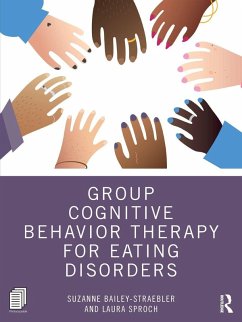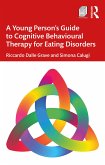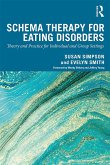- Broschiertes Buch
- Merkliste
- Auf die Merkliste
- Bewerten Bewerten
- Teilen
- Produkt teilen
- Produkterinnerung
- Produkterinnerung
This treatment guide equips therapists with the necessary tools to implement the leading recommended treatment for eating disorders, 'enhanced' cognitive behavior therapy (CBT-E), in a group format.
Andere Kunden interessierten sich auch für
![Treating Bulimia Nervosa and Binge Eating Treating Bulimia Nervosa and Binge Eating]() Myra Cooper (UK University of Oxford)Treating Bulimia Nervosa and Binge Eating57,99 €
Myra Cooper (UK University of Oxford)Treating Bulimia Nervosa and Binge Eating57,99 €![Family Based Treatment for Restrictive Eating Disorders Family Based Treatment for Restrictive Eating Disorders]() Sarah ForsbergFamily Based Treatment for Restrictive Eating Disorders49,99 €
Sarah ForsbergFamily Based Treatment for Restrictive Eating Disorders49,99 €![Transforming Emotional Pain and Rediscovering the Self in Anorexia Nervosa Transforming Emotional Pain and Rediscovering the Self in Anorexia Nervosa]() Anna OldershawTransforming Emotional Pain and Rediscovering the Self in Anorexia Nervosa42,99 €
Anna OldershawTransforming Emotional Pain and Rediscovering the Self in Anorexia Nervosa42,99 €![Eating Disorder Group Therapy Eating Disorder Group Therapy]() Carolyn KarollEating Disorder Group Therapy39,99 €
Carolyn KarollEating Disorder Group Therapy39,99 €![A Young Person's Guide to Cognitive Behavioural Therapy for Eating Disorders A Young Person's Guide to Cognitive Behavioural Therapy for Eating Disorders]() Riccardo Dalle GraveA Young Person's Guide to Cognitive Behavioural Therapy for Eating Disorders24,99 €
Riccardo Dalle GraveA Young Person's Guide to Cognitive Behavioural Therapy for Eating Disorders24,99 €![Schema Therapy for Eating Disorders Schema Therapy for Eating Disorders]() Schema Therapy for Eating Disorders32,99 €
Schema Therapy for Eating Disorders32,99 €![Chronic Illness and Eating Disorders Chronic Illness and Eating Disorders]() Tamie GangloffChronic Illness and Eating Disorders167,99 €
Tamie GangloffChronic Illness and Eating Disorders167,99 €-
-
-
This treatment guide equips therapists with the necessary tools to implement the leading recommended treatment for eating disorders, 'enhanced' cognitive behavior therapy (CBT-E), in a group format.
Produktdetails
- Produktdetails
- Verlag: Taylor & Francis Ltd
- Seitenzahl: 398
- Erscheinungstermin: 29. Mai 2025
- Englisch
- Abmessung: 280mm x 210mm x 21mm
- Gewicht: 962g
- ISBN-13: 9781032586236
- ISBN-10: 1032586230
- Artikelnr.: 71659793
- Herstellerkennzeichnung
- Libri GmbH
- Europaallee 1
- 36244 Bad Hersfeld
- gpsr@libri.de
- Verlag: Taylor & Francis Ltd
- Seitenzahl: 398
- Erscheinungstermin: 29. Mai 2025
- Englisch
- Abmessung: 280mm x 210mm x 21mm
- Gewicht: 962g
- ISBN-13: 9781032586236
- ISBN-10: 1032586230
- Artikelnr.: 71659793
- Herstellerkennzeichnung
- Libri GmbH
- Europaallee 1
- 36244 Bad Hersfeld
- gpsr@libri.de
Suzanne Bailey-Straebler, PhD, PMH-BC, is Clinical Director of the Center for Eating Disorders Partial Hospital Program and Outpatient Specialty Clinic at Weill Cornell Medicine, New York Presbyterian Hospital. Laura Sproch, PhD, CED-S, is a clinical psychologist who specializes in the treatment of eating disorders through her work as a therapist, supervisor, researcher, and administrator.
1. An Introduction to This Book 2. Eating Disorders and Enhanced Cognitive
Behavior Therapy 3. Pre-treatment Assessment and Contraindications to
Starting Outpatient Group CBT-E 4. Group CBT-E: Overview and Treatment
Structure 5. Group CBT-E: Elements and Therapist Characteristics
Group CBT-E Sessions Stage One: Achieving Early Change 6. Group Session 1:
Introductions, Personalized Formulations, and Self-Monitoring 7. Group
Session 2: Personalized Formulation and Self-Monitoring Review and Regular
Eating 8. Group Session 3: Regular Eating and Alternative Activities 9.
Group Session 4 Regular Eating, Urge Tolerating, and Feelings of Fullness
Stage Two: Reviewing Progress 10. Group Session 5: Progress Review Stage
Three: Maintaining Mechanisms 11. Group Session 6 : Dieting Behaviors and
Diet-related Rules 12. Group Session 7: The Over-evaluation of Shape and
Weight and Its Consequences 13. Group Session 8: Body Shape and Weight
Checking - Part I: Education, Evaluation, and Behavior Change 14. Group
Session 9: Body Shape and Weight Checking - Part II: Reflection Checking,
Body Comparisons, and Social Media Body Checking 15. Group Session 10: Body
Shape and Weight Avoidance 16. Group Session 11: Stage Three Check-in and
Body Dissatisfaction Spikes 17. Group Session 12: Events, Emotions, and
Eating Stage Four: Ending Well 18. Group Session 13: Historical Review of
Eating Disorder Behaviors and Thoughts 19. Group Session 14: Relapse
Prevention and Ending Treatment Appendices Index
Behavior Therapy 3. Pre-treatment Assessment and Contraindications to
Starting Outpatient Group CBT-E 4. Group CBT-E: Overview and Treatment
Structure 5. Group CBT-E: Elements and Therapist Characteristics
Group CBT-E Sessions Stage One: Achieving Early Change 6. Group Session 1:
Introductions, Personalized Formulations, and Self-Monitoring 7. Group
Session 2: Personalized Formulation and Self-Monitoring Review and Regular
Eating 8. Group Session 3: Regular Eating and Alternative Activities 9.
Group Session 4 Regular Eating, Urge Tolerating, and Feelings of Fullness
Stage Two: Reviewing Progress 10. Group Session 5: Progress Review Stage
Three: Maintaining Mechanisms 11. Group Session 6 : Dieting Behaviors and
Diet-related Rules 12. Group Session 7: The Over-evaluation of Shape and
Weight and Its Consequences 13. Group Session 8: Body Shape and Weight
Checking - Part I: Education, Evaluation, and Behavior Change 14. Group
Session 9: Body Shape and Weight Checking - Part II: Reflection Checking,
Body Comparisons, and Social Media Body Checking 15. Group Session 10: Body
Shape and Weight Avoidance 16. Group Session 11: Stage Three Check-in and
Body Dissatisfaction Spikes 17. Group Session 12: Events, Emotions, and
Eating Stage Four: Ending Well 18. Group Session 13: Historical Review of
Eating Disorder Behaviors and Thoughts 19. Group Session 14: Relapse
Prevention and Ending Treatment Appendices Index
1. An Introduction to This Book 2. Eating Disorders and Enhanced Cognitive
Behavior Therapy 3. Pre-treatment Assessment and Contraindications to
Starting Outpatient Group CBT-E 4. Group CBT-E: Overview and Treatment
Structure 5. Group CBT-E: Elements and Therapist Characteristics
Group CBT-E Sessions Stage One: Achieving Early Change 6. Group Session 1:
Introductions, Personalized Formulations, and Self-Monitoring 7. Group
Session 2: Personalized Formulation and Self-Monitoring Review and Regular
Eating 8. Group Session 3: Regular Eating and Alternative Activities 9.
Group Session 4 Regular Eating, Urge Tolerating, and Feelings of Fullness
Stage Two: Reviewing Progress 10. Group Session 5: Progress Review Stage
Three: Maintaining Mechanisms 11. Group Session 6 : Dieting Behaviors and
Diet-related Rules 12. Group Session 7: The Over-evaluation of Shape and
Weight and Its Consequences 13. Group Session 8: Body Shape and Weight
Checking - Part I: Education, Evaluation, and Behavior Change 14. Group
Session 9: Body Shape and Weight Checking - Part II: Reflection Checking,
Body Comparisons, and Social Media Body Checking 15. Group Session 10: Body
Shape and Weight Avoidance 16. Group Session 11: Stage Three Check-in and
Body Dissatisfaction Spikes 17. Group Session 12: Events, Emotions, and
Eating Stage Four: Ending Well 18. Group Session 13: Historical Review of
Eating Disorder Behaviors and Thoughts 19. Group Session 14: Relapse
Prevention and Ending Treatment Appendices Index
Behavior Therapy 3. Pre-treatment Assessment and Contraindications to
Starting Outpatient Group CBT-E 4. Group CBT-E: Overview and Treatment
Structure 5. Group CBT-E: Elements and Therapist Characteristics
Group CBT-E Sessions Stage One: Achieving Early Change 6. Group Session 1:
Introductions, Personalized Formulations, and Self-Monitoring 7. Group
Session 2: Personalized Formulation and Self-Monitoring Review and Regular
Eating 8. Group Session 3: Regular Eating and Alternative Activities 9.
Group Session 4 Regular Eating, Urge Tolerating, and Feelings of Fullness
Stage Two: Reviewing Progress 10. Group Session 5: Progress Review Stage
Three: Maintaining Mechanisms 11. Group Session 6 : Dieting Behaviors and
Diet-related Rules 12. Group Session 7: The Over-evaluation of Shape and
Weight and Its Consequences 13. Group Session 8: Body Shape and Weight
Checking - Part I: Education, Evaluation, and Behavior Change 14. Group
Session 9: Body Shape and Weight Checking - Part II: Reflection Checking,
Body Comparisons, and Social Media Body Checking 15. Group Session 10: Body
Shape and Weight Avoidance 16. Group Session 11: Stage Three Check-in and
Body Dissatisfaction Spikes 17. Group Session 12: Events, Emotions, and
Eating Stage Four: Ending Well 18. Group Session 13: Historical Review of
Eating Disorder Behaviors and Thoughts 19. Group Session 14: Relapse
Prevention and Ending Treatment Appendices Index








